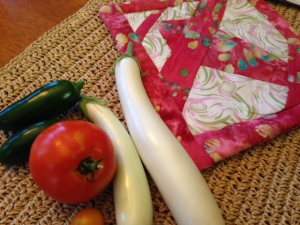I’ve been meaning to try this for a while, and finally cooked it this weekend. It is perfect for an office day meal. I do love one pot meals!
I swapped in Quinoa, instead of rice, as has been the norm lately in my routine.
Ingredients:
2/3 cup white Quinoa
1/3 cup Toor dal (Pigeon Pea)
1 small white or yellow onion cut into 1in pieces
1 jalapeno, sliced
1 Chayote squash, peeled and cut into 1in pieces (typically bottle guard is used, but I often substitute with Chayote Squash)
1-2 medium tomatoes, chopped into large pieces
2/3 rd cup tamarind juice
1.5 cups water
1 tsp oil
a dash of turmeric
a dash of asaphoetida
1 tsp mustard seeds
1 tsp cumin seeds
2-3 dry red chillies
2-3 tsp Bisibele powder, I typically use the MTR variety
2-3 tbsp fresh (or dry) grated coconut
a few curry leaves
cilantro to garnish
coconut slices to garnish
salt to taste
2-3 tbsp ghee (optional)
I like to use a pressure pan to cook this. Heat oil in the pressure pan, add turmeric, asaphoetida, cumin, mustard and dry red chillies and fry for a minute till lightly brown. Add onions, jalapeno, curry leaves and squash and fry lightly. Add tomatoes and mix well.
Rinse and add Quinoa and toor dal and mix well. Add bisibele bath powder, salt and coconut powder and mix well. Add water and tamarind juice and mix well. Close pressure cooker lid and let simmer on medium low for 2-3 whistles. What makes this dish especially yummy is to add 2-3 tbsp of ghee!
Let cool, before opening the pressure pan. Garnish with cilantro and coconut slices and serve warm.
Makes 3 servings.

























